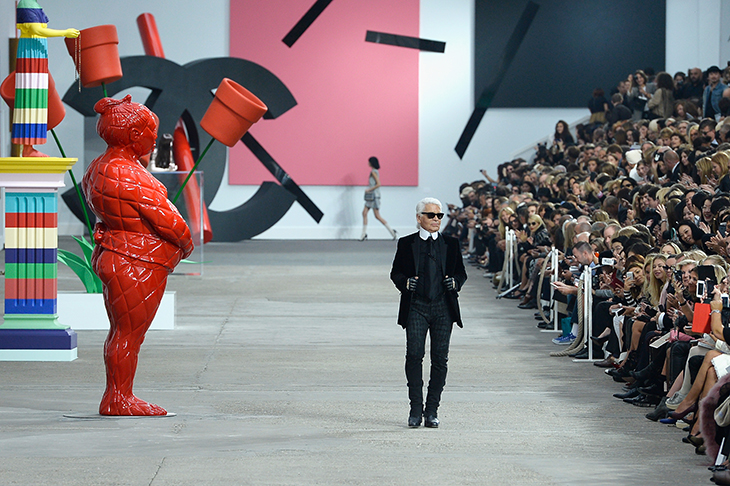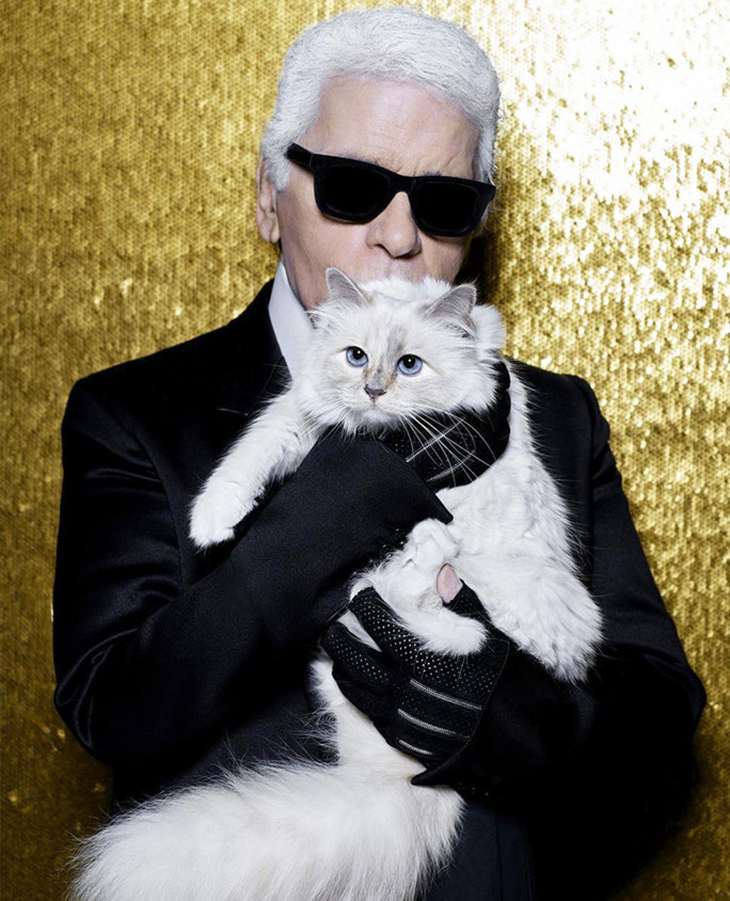In 1954, a newly established international design award judged by the couturiers Pierre Balmain and Hubert de Givenchy – the Woolmark Prize – was presented to two promising but obscure new designers. The first was a young Parisian, virtually unknown, called Yves Saint Laurent. Alongside him, wearing a slim suit and an Everly Brothers haircut, was a German designer by the name of Karl Lagerfeld. It is astonishing to think that 65 years later he was still one of the most powerful and influential figures in the fashion world.
With the passing of Karl Lagerfeld – who died on Tuesday 19 February 2019 at the age of 85 – the last major link to the golden age of haute couture has, arguably, been severed. He trained under Balmain, and joined the Italian house of Fendi in 1965, but it is without doubt his role in revitalising Chanel that will be his lasting legacy. When he was appointed creative director in 1983, the storied maison had become staid, predictable and somewhat irrelevant (‘bourgeois’, in Lagerfeld’s terms). He brought to it a shot of adrenaline and extreme profitability. Season after season he would assemble and recombine the house’s familiar pieces – the bouclé tweeds, the quilted bags, the chain belts, the gilt buttons – in fresh ways that felt at once part of a continuity with Chanel’s past and relevant for the present. He could adapt these signature styles for every era: brash and boxy for the 1980s, tiny and slinky for the mid 1990s.

Karl Lagerfeld at the Chanel show during Paris Fashion Week, 2014. Photo: © Pascal Le Segretain/Getty Images
And as the world moved ever more into a society of spectacle with the advent of the internet and social media, Lagerfeld played it like a master, turning Chanel catwalk presentations into increasingly extravagant events designed for viral appeal, such that the glum procession of models and (dare one say it) even the clothes were overshadowed by the staging. The echoing beaux-arts hall of Paris’s Grand Palais played host to a faux political rally, with models wielding placards and megaphones; a tropical beach with genuine lapping waves; and, most breathtaking of all, an interplanetary space station with a rocket that appeared to launch at the climax.
Lagerfeld’s innate understanding of the power of the image was also abundantly clear in the way he presented himself. Like many of fashion’s major players, he favoured an easily identifiable personal uniform: a high starched collar that encircled his throat like a corset; a kipper tie; little black driving gloves; dark glasses at all times; a snow-white pompadour trained into a queue at the back of his neck. The effect was somewhere between a footman in Directoire-era Paris and a Bond villain. He even had the fluffy white cat to match (a long-haired Birman called Choupette that has a quarter of a million Instagram followers and looks set to inherit Lagerfeld’s estate).

Karl Lagerfeld with his cat, Choupette. Photo via Instagram
It was easy to regard Lagerfeld as austere and humourless; but there was always a feeling that he revelled in it, that he regarded himself with a Teutonic sense of self-parody where to be thought of as without humour was all part of the joke. Certainly his taste for epigrams – often as acidic as a facial skin peel – do not suggest a man without humour. ‘Sweatpants are a sign of defeat,’ he famously averred. ‘You lost control of your life, so you bought some sweatpants.’
Fashion is a discipline all about superficiality, where surface is prized as much as depth. But Karl Lagerfeld had depths. As well as his prolific career as designer, predicated on a talent for draughtsmanship that was typical of the couturiers of his vintage, he was also a gifted photographer and a patron of the arts. His various homes around the world were lavish essays on his acquired tastes, replete with antique furniture and complemented with era-specific paintings and sculpture. These ranged from Fragonard and Boucher to Bruno Paul and the Memphis Group, ruminations on specific art-historical periods that were swiftly disposed of at auction when his attentions moved on to something else. The same principle of steeping himself in research and culture, only to dispose of it when his tastes changed, applied also to his own work. He had a huge visual library, which he claimed numbered 300,000 volumes (mostly coffee-table books, stacked horizontally), but he kept no archive of his own sketches.
He was many things – a showman; a businessman; a connoisseur; a designer of furniture; a waxwork Beau Brummell – but arguably his greatest work was the creation of Karl Lagerfeld himself. ‘I am like a caricature of myself,’ he said, ‘and I like that.’

Karl Lagerfeld’s greatest creation was himself
Karl Lagerfeld with Cara Delevingne during the Chanel show at Paris Fashion Week, 2014. Photo: Francois Durand/Getty Images
Share
In 1954, a newly established international design award judged by the couturiers Pierre Balmain and Hubert de Givenchy – the Woolmark Prize – was presented to two promising but obscure new designers. The first was a young Parisian, virtually unknown, called Yves Saint Laurent. Alongside him, wearing a slim suit and an Everly Brothers haircut, was a German designer by the name of Karl Lagerfeld. It is astonishing to think that 65 years later he was still one of the most powerful and influential figures in the fashion world.
With the passing of Karl Lagerfeld – who died on Tuesday 19 February 2019 at the age of 85 – the last major link to the golden age of haute couture has, arguably, been severed. He trained under Balmain, and joined the Italian house of Fendi in 1965, but it is without doubt his role in revitalising Chanel that will be his lasting legacy. When he was appointed creative director in 1983, the storied maison had become staid, predictable and somewhat irrelevant (‘bourgeois’, in Lagerfeld’s terms). He brought to it a shot of adrenaline and extreme profitability. Season after season he would assemble and recombine the house’s familiar pieces – the bouclé tweeds, the quilted bags, the chain belts, the gilt buttons – in fresh ways that felt at once part of a continuity with Chanel’s past and relevant for the present. He could adapt these signature styles for every era: brash and boxy for the 1980s, tiny and slinky for the mid 1990s.
Karl Lagerfeld at the Chanel show during Paris Fashion Week, 2014. Photo: © Pascal Le Segretain/Getty Images
And as the world moved ever more into a society of spectacle with the advent of the internet and social media, Lagerfeld played it like a master, turning Chanel catwalk presentations into increasingly extravagant events designed for viral appeal, such that the glum procession of models and (dare one say it) even the clothes were overshadowed by the staging. The echoing beaux-arts hall of Paris’s Grand Palais played host to a faux political rally, with models wielding placards and megaphones; a tropical beach with genuine lapping waves; and, most breathtaking of all, an interplanetary space station with a rocket that appeared to launch at the climax.
Lagerfeld’s innate understanding of the power of the image was also abundantly clear in the way he presented himself. Like many of fashion’s major players, he favoured an easily identifiable personal uniform: a high starched collar that encircled his throat like a corset; a kipper tie; little black driving gloves; dark glasses at all times; a snow-white pompadour trained into a queue at the back of his neck. The effect was somewhere between a footman in Directoire-era Paris and a Bond villain. He even had the fluffy white cat to match (a long-haired Birman called Choupette that has a quarter of a million Instagram followers and looks set to inherit Lagerfeld’s estate).
Karl Lagerfeld with his cat, Choupette. Photo via Instagram
It was easy to regard Lagerfeld as austere and humourless; but there was always a feeling that he revelled in it, that he regarded himself with a Teutonic sense of self-parody where to be thought of as without humour was all part of the joke. Certainly his taste for epigrams – often as acidic as a facial skin peel – do not suggest a man without humour. ‘Sweatpants are a sign of defeat,’ he famously averred. ‘You lost control of your life, so you bought some sweatpants.’
Fashion is a discipline all about superficiality, where surface is prized as much as depth. But Karl Lagerfeld had depths. As well as his prolific career as designer, predicated on a talent for draughtsmanship that was typical of the couturiers of his vintage, he was also a gifted photographer and a patron of the arts. His various homes around the world were lavish essays on his acquired tastes, replete with antique furniture and complemented with era-specific paintings and sculpture. These ranged from Fragonard and Boucher to Bruno Paul and the Memphis Group, ruminations on specific art-historical periods that were swiftly disposed of at auction when his attentions moved on to something else. The same principle of steeping himself in research and culture, only to dispose of it when his tastes changed, applied also to his own work. He had a huge visual library, which he claimed numbered 300,000 volumes (mostly coffee-table books, stacked horizontally), but he kept no archive of his own sketches.
He was many things – a showman; a businessman; a connoisseur; a designer of furniture; a waxwork Beau Brummell – but arguably his greatest work was the creation of Karl Lagerfeld himself. ‘I am like a caricature of myself,’ he said, ‘and I like that.’
Unlimited access from just $16 every 3 months
Subscribe to get unlimited and exclusive access to the top art stories, interviews and exhibition reviews.
Share
Recommended for you
Haute couture and holy robes at the Met
High fashion turns out to be no match for some lavish loans from the Vatican
Hubert de Givenchy (1927–2018)
Hubert de Givenchy, the celebrated couturier and collector of fine and decorative art, has died at at the age of 91
How Liberty looked to the past to imagine the future of fashion
More than a century’s worth of Liberty fabrics and designs make for an enjoyable survey of the brand’s history